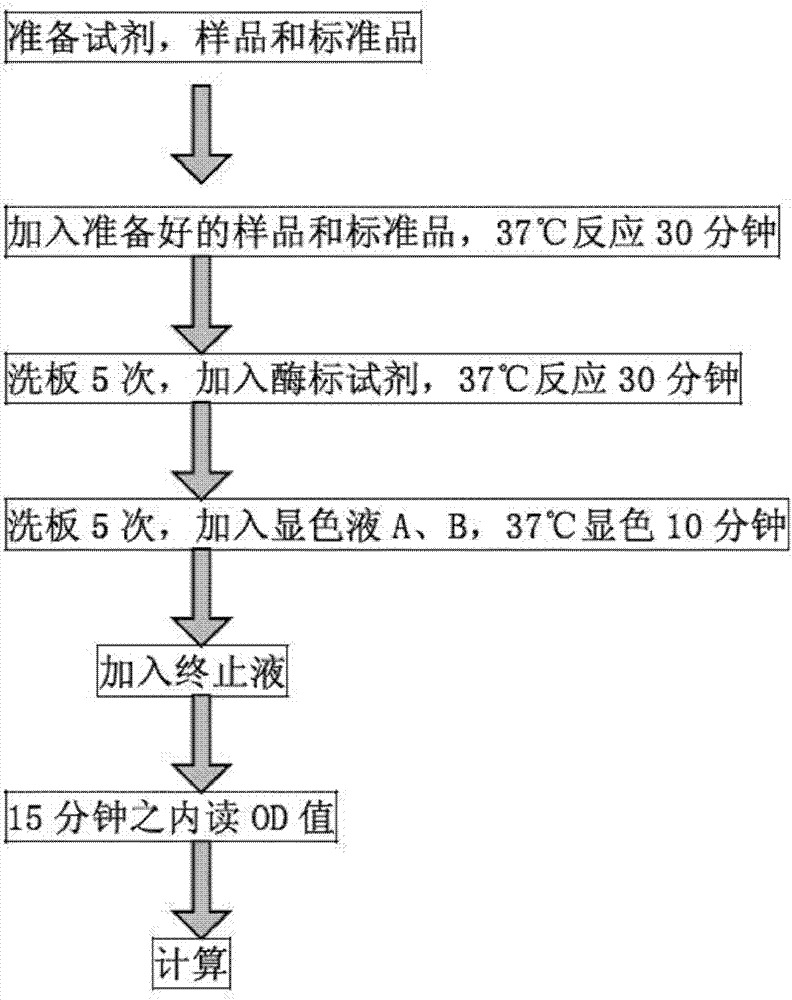Method for detecting urine fibronectin, and kit thereof
A technology of fibronectin and urine, which is applied in the field of medical testing, can solve problems such as low willingness for self-discipline inspection, influence of operator's technical level, unstandardized use methods, etc., and achieve good economic benefits, good social and economic benefits , the effect of reducing the economic burden
- Summary
- Abstract
- Description
- Claims
- Application Information
AI Technical Summary
Problems solved by technology
Method used
Image
Examples
Embodiment 1
[0044] like figure 1 Shown:
[0045] A method for detecting urinary fibronectin, the operation steps are as follows:
[0046] Detection principle:
[0047] The content of fibronectin (FN) in human urine was determined by enzyme-linked immunosorbent assay. The pre-coated FN in the microtiter plate and the FN in the urine are competitively combined with the FN antibody. After adding the enzyme-labeled antibody, an antigen-antibody complex is formed. The colorimetry is performed at a wavelength of 492nm, and the FN content and OD value in the urine are to be determined. (492nm) is directly proportional.
[0048] Specimen collection:
[0049] Take the first morning urine. When collecting urine, instruct the patient to abstain from water after 10:00 p.m. the night before. After the urine sample is centrifuged at 3,000r / min for 10 minutes, the supernatant is collected and placed in a clean container at 2-8°C. It can be stored for 48 hours, and can be stored for 1 month at -20°C. ...
Embodiment 2
[0066] Patients with transitional epithelial carcinoma of the bladder at different stages, patients with benign urinary tract diseases (group A without urinary tract infection, group B with urinary tract infection), renal cell carcinoma, hamartoma and adrenocortical tumor (group c) , non-urinary system malignant tumor (group D) patients and normal control group urine crossing, serum fibronectin FN concentration.
[0067] Except for 5 patients with BTCC, samples were collected before operation and 10-16 days after operation, and samples were collected before operation for other patients. Take the morning urine or more than 2 small pairs of urine in the bladder from the patients and normal controls, centrifuge at 2,000r / min for 10min, draw the supernatant and put it in a -20℃ refrigerator. At the same time as the urine wave was collected, fasting peripheral venous blood was drawn, the serum was separated within 3 hours, and stored in a -20°C refrigerator for later use.
[0068]...
Embodiment 3
[0089] 1. Materials and Methods
[0090] 1. Clinical data
[0091] 1) Bladder cancer group: 50 cases. There were 34 males and 16 females. Aged 26-82 years old, with an average of 62 years old. The pathological types were transitional cell carcinoma of the bladder. According to the International Union Against Cancer (UICC) staging: T 1 29 cases, T 2 17 cases, T 3 4 cases. Pathological grade: G 1 18 cases, G 2 24 cases, G 3 8 cases. 50 patients with bladder cancer underwent partial cystectomy in 42 cases, laser therapy in 5 cases, and total cystectomy in 3 cases. All tumors were completely removed. Urine samples were collected from each patient before operation and 1 month after operation.
[0092] 2) Non-bladder cancer group: a total of 30 patients with other genitourinary diseases. There were 18 males and 12 females. Aged 34-76 years old, with an average of 60 years old. Among them (1) 20 cases of benign genitourinary diseases group, 12 males and 8 females aged ...
PUM
 Login to View More
Login to View More Abstract
Description
Claims
Application Information
 Login to View More
Login to View More - R&D
- Intellectual Property
- Life Sciences
- Materials
- Tech Scout
- Unparalleled Data Quality
- Higher Quality Content
- 60% Fewer Hallucinations
Browse by: Latest US Patents, China's latest patents, Technical Efficacy Thesaurus, Application Domain, Technology Topic, Popular Technical Reports.
© 2025 PatSnap. All rights reserved.Legal|Privacy policy|Modern Slavery Act Transparency Statement|Sitemap|About US| Contact US: help@patsnap.com

